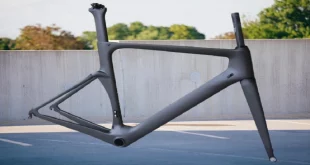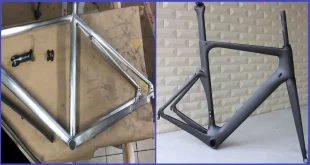Carbon bike frames are generally considered to be better than aluminum bike frames due to their lightweight and superior vibration damping properties. With their excellent stiffness-to-weight ratio, carbon frames offer enhanced efficiency and a smoother ride compared to their aluminum counterparts.
Understanding The Difference
Are carbon bike frames better than aluminum bike frames? This is a question that many cyclists ponder when choosing a new bike. Understanding the difference between these two frame materials can help you make an informed decision. In this section, we will explore the pros and cons of carbon frames and aluminum frames, highlighting their unique qualities and benefits.
Intro To Carbon And Aluminum Bike Frames
- Carbon frames: Constructed using carbon fiber, these frames have become increasingly popular in the cycling world. Carbon fiber is a lightweight and strong material that allows for great flexibility in frame design. Carbon frames offer excellent vibration damping capabilities, providing a smoother ride on rough terrain.
- Aluminum frames: Aluminum is a lightweight and relatively affordable material commonly used in bike frame construction. Aluminum frames are known for their stiffness and responsiveness, delivering efficient power transfer during pedaling. They are also durable and resistant to corrosion, making them a popular choice among riders.
Pros And Cons Of Carbon Frames
- Lightweight: Carbon frames are significantly lighter than aluminum frames, offering an advantage in terms of overall bike weight. A lighter bike allows for better acceleration and climbing performance.
- Vibration damping: Carbon’s ability to absorb vibrations from the road results in a smoother and more comfortable ride. This feature is especially beneficial for long-distance rides or rough road conditions.
- Customization: Carbon frames allow for greater design flexibility, enabling manufacturers to create aerodynamic shapes and unique frame geometries. This customization can optimize the bike’s performance and cater to individual preferences.
- Cost: Carbon frames tend to be more expensive compared to aluminum frames. The complexity of production and the cost of carbon fiber contribute to their higher price point.
- Durability: Carbon frames, though strong, can be susceptible to impacts and damage. In some cases, the structural integrity may be compromised, necessitating repairs or replacement.
Pros And Cons Of Aluminum Frames
- Affordability: Aluminum frames are generally more affordable compared to carbon frames, making them an attractive option for budget-conscious riders.
- Stiffness and responsiveness: Aluminum frames are known for their stiffness, providing a direct and efficient transfer of power from the rider to the pedals. This characteristic makes them well-suited for sprinting or fast-paced riding.
- Durability: Aluminum frames are durable and resistant to corrosion, making them suitable for various weather conditions. They can withstand everyday wear and tear, requiring minimal maintenance.
- Weight: Aluminum frames are slightly heavier than carbon frames, which can have a minor impact on overall bike weight and performance.
- Ride quality: Aluminum frames may transmit more road vibrations to the rider, resulting in a slightly harsher ride compared to carbon frames.
Understanding the differences between carbon and aluminum frames is crucial when choosing a bike that suits your riding style and preferences. Carbon frames offer lightweight, vibration damping, and customization benefits, but they come at a higher cost. On the other hand, aluminum frames are more affordable, durable, and offer excellent stiffness, making them popular among budget-conscious riders.
Ultimately, the choice between carbon and aluminum frames depends on your specific needs and priorities as a cyclist.
Performance And Weight
Impact Of Frame Material On Bike Performance
When it comes to bike performance, the frame material plays a crucial role. Both carbon and aluminum frames have their own set of advantages, and understanding their impact on bike performance is essential in making an informed decision. Here are the key points to consider:
- Carbon frames are known for their superior strength and stiffness, which translates into excellent power transfer. This means that when you pedal, more of your energy is efficiently transferred to the wheels, resulting in increased speed.
- On the other hand, aluminum frames are more compliant and offer a slightly smoother ride due to their ability to absorb vibrations. This can be particularly beneficial when riding on rough surfaces or for long-distance rides where comfort is a priority.
Comparing The Weight Of Carbon And Aluminum Frames
Weight is another important factor to consider when choosing between carbon and aluminum frames. Here’s a brief overview of their weight characteristics:
- Carbon frames are renowned for their feather-light weight. They are incredibly light and offer impressive stiffness, making them a popular choice among professional cyclists who prioritize speed and performance.
- Aluminum frames, while typically heavier than carbon frames, have made significant progress in recent years. Advances in aluminum alloy technology have resulted in lighter frames that still offer great strength and durability.
How Weight Affects Speed, Handling, And Efficiency
The weight of the bike frame can have a significant impact on speed, handling, and overall efficiency. Here’s how it comes into play:
- Speed: Lighter frames, such as carbon frames, have a clear advantage when it comes to speed. A lighter bike requires less effort to accelerate and maintain higher speeds, allowing you to ride faster and potentially achieve better race times.
- Handling: While carbon frames excel in speed, aluminum frames tend to offer better handling characteristics. The slightly heavier weight can provide a more stable and predictable ride, especially during cornering and descending.
- Efficiency: In terms of efficiency, lighter frames offer an advantage when climbing hills or navigating challenging terrain. The reduced weight minimizes the energy required to tackle inclines, allowing you to conserve energy and achieve a more efficient ride.
Both carbon and aluminum bike frames have their own unique benefits and considerations. Carbon frames are lighter and stiffer, offering enhanced speed and power transfer, while aluminum frames provide a smoother and more compliant ride. Understanding the impact of frame material on bike performance, weight, and handling allows you to make an informed decision based on your specific needs and riding preferences.
Durability And Longevity
When it comes to choosing a bike frame material, durability and longevity are essential factors to consider. Carbon and aluminum frames are two popular options among cyclists, each with its own strengths and weaknesses. In this section, we will evaluate the durability of carbon frames and assess the durability of aluminum frames.
Additionally, we will explore the factors that affect the longevity of both frame materials. So, without further ado, let’s dive in.
Evaluating The Durability Of Carbon Frames
Carbon bike frames are known for their lightweight and high strength-to-weight ratio. Here are some key points to consider when assessing the durability of carbon frames:
- Carbon frames are resistant to fatigue and have a higher strength compared to aluminum frames. This makes them less prone to cracks and fractures, especially under high-stress situations.
- The composite nature of carbon frames allows for better shock absorption, which can contribute to a more comfortable ride. The material’s ability to dampen vibrations can help reduce fatigue and improve overall durability.
- Carbon frames are corrosion-resistant, making them ideal for riders who frequently expose their bikes to harsh weather conditions or saltwater environments.
Assessing The Durability Of Aluminum Frames
While carbon frames are highly regarded for their durability, aluminum frames also have their own merits. Let’s take a look at the key points when assessing the durability of aluminum frames:
- Aluminum frames are generally more affordable compared to carbon frames, making them a popular choice for budget-conscious cyclists. Despite their lower price point, aluminum frames offer notable durability.
- Aluminum is naturally more resistant to impact and bending than carbon. This resilience can contribute to a longer lifespan, especially in situations where the frame may experience accidental drops or impacts.
- However, aluminum frames can be more prone to fatigue and stress fractures over time, particularly when exposed to repetitive high-stress situations. It is crucial to carefully inspect and maintain an aluminum frame to ensure its long-term durability.
Factors That Affect The Longevity Of Both Frame Materials
Apart from the inherent characteristics of the frame materials, several factors can affect the longevity of both carbon and aluminum frames. Here are some important points to consider:
Carbon frames:
- The quality of carbon fiber used in the construction of the frame plays a significant role in its durability. Premium carbon fibers offer higher strength and stiffness, enhancing the frame’s overall longevity.
- Proper care and maintenance, such as avoiding extreme temperatures and regularly inspecting the frame for any signs of damage, are crucial for maximizing the lifespan of a carbon frame.
- In the event of a crash or accident, carbon frames can experience hidden internal damage that may compromise their structural integrity. It’s essential to have a professional inspection following such incidents.
Aluminum frames:
- Aluminum frames require regular cleaning and maintenance to prevent corrosion, which can significantly impact their longevity. This includes timely application of protective coatings and addressing any damage or scratches to the frame’s surface.
- Proper torque specifications when assembling components onto an aluminum frame are crucial to prevent stress concentration and potential fatigue failure.
- The design and construction of the aluminum frame, including factors like tube shaping and buttressing, can influence its overall durability and resistance to fatigue.
Both carbon and aluminum frames have their pros and cons when it comes to durability and longevity. The choice between the two ultimately depends on individual preferences, budget, riding style, and intended use. By understanding the unique characteristics and factors affecting the durability of each material, riders can make an informed decision when selecting their next bike frame.
Remember, regular maintenance and proper care are key to maximizing the lifespan of any frame, regardless of the material.
Comfort And Ride Quality
Carbon bike frames and aluminum bike frames are both popular choices among cyclists, but when it comes to comfort and ride quality, there are some notable differences. Exploring the comfort of carbon frames (###), we can see that:
- Carbon frames are known for their ability to absorb vibrations and dampen road shock, providing a smoother and more comfortable ride.
- The carbon fiber construction allows the frame to flex and absorb impacts, minimizing the impact on the rider’s body.
- This means that carbon frames can offer a more forgiving ride, especially on rougher terrains or longer rides.
- The material’s inherent properties also contribute to reduced fatigue, as it helps to reduce the vibrations and stress that can be transferred to the rider.
On the other hand, discussing the ride quality of aluminum frames, we find that:
- Aluminum frames tend to be stiffer and provide a more responsive ride compared to carbon frames.
- The stiffness of the material allows for better power transfer, enabling riders to generate more speed and acceleration.
- However, this stiffness can also lead to a harsher ride experience, especially on uneven roads or over longer distances.
- Aluminum frames are more rigid and do not have the same level of vibration damping as carbon frames.
When it comes to how frame material affects vibration damping and shock absorption, it’s important to note that:
- Carbon frames have a natural ability to absorb and dampen vibrations due to the flexibility of the carbon fiber material.
- This means that riders are less likely to feel the impact of bumps and uneven surfaces.
- Aluminum frames, on the other hand, tend to transmit more of these vibrations to the rider’s body, resulting in a bumpier and less comfortable ride.
While carbon frames offer superior comfort and ride quality due to their vibration absorption and shock absorption properties, aluminum frames are known for their stiff and responsive ride. Ultimately, the choice between carbon and aluminum frames depends on the rider’s personal preferences and the type of terrain they will be riding on.
Cost And Value For Money
When it comes to choosing the right bike frame, the debate between carbon and aluminum frames is a hot topic among cycling enthusiasts. Both materials have their own unique advantages and disadvantages, but one factor that often plays a significant role in the decision-making process is cost and value for money.
Let’s analyze the cost of carbon frames and assess the cost of aluminum frames, before determining the value for money of both frame materials.
Analyzing The Cost Of Carbon Frames:
- Carbon frames are typically more expensive than aluminum frames.
- The manufacturing process of carbon frames involves complex techniques, which contribute to higher production costs.
- The use of high-quality carbon fibers increases the overall price of carbon frames.
- However, advancements in technology have made carbon frames more affordable in recent years.
- The cost of carbon frames can vary depending on the brand, the type of carbon used, and the level of craftsmanship.
Assessing The Cost Of Aluminum Frames:
- Aluminum frames are generally more affordable compared to carbon frames.
- The manufacturing process of aluminum frames is less complex, resulting in lower production costs.
- The availability of aluminum as a material contributes to its lower price point.
- However, factors such as frame design and brand reputation can also influence the cost of aluminum frames.
Determining The Value For Money Of Both Frame Materials:
- Carbon frames offer several advantages that justify their higher price tag, including lighter weight and increased stiffness.
- The lightweight nature of carbon frames allows for better acceleration and climbing, enhancing overall performance.
- Carbon frames also provide better shock absorption, resulting in a more comfortable ride.
- Aluminum frames, on the other hand, offer durability and strength at a more budget-friendly price.
- While they may not match the performance benefits of carbon, aluminum frames are known for their reliability and longevity.
Ultimately, the value for money depends on individual preferences, budget, and riding style. Cyclists seeking top-notch performance and willing to invest more may find carbon frames more suitable. On the other hand, those looking for a cost-effective option without compromising on durability may opt for aluminum frames.
It’s important to carefully consider your priorities and consult with experts or experienced riders before making a decision.
Maintenance And Repair
Carbon bike frames and aluminum bike frames are two popular choices among cyclists. Both materials have their own unique features and advantages. In this section, we will explore the maintenance and repair aspects of these frames to help you make an informed decision.
Maintenance Requirements For Carbon Frames:
Carbon frames are generally more lightweight and sleek compared to aluminum frames. However, they require a bit more attention when it comes to maintenance. Here are some key points to consider:
- Inspect the frame regularly for any signs of damage, such as cracks or dents.
- Clean the frame with mild soapy water and a soft brush to remove dirt and grime.
- Avoid using harsh chemicals or solvents, as they can damage the carbon fiber.
- Apply a protective wax or polish to keep the frame looking its best.
- Check the torque on the bike’s components to ensure everything is properly tightened.
Maintenance Requirements For Aluminum Frames:
Aluminum frames are known for their durability and strength. They require less maintenance compared to carbon frames. Here are some important tips to keep in mind:
- Regularly inspect the frame for any signs of corrosion or structural damage.
- Clean the frame with mild soapy water and a soft brush to remove dirt and debris.
- Apply a protective coating or wax to prevent oxidation and maintain the frame’s appearance.
- Check the bolts and fasteners periodically to ensure they are tightened properly.
Availability And Cost Of Repairs:
When it comes to repairs, both carbon and aluminum frames have their own considerations in terms of availability and cost. Here are some points to consider:
- Carbon frame repairs are typically more specialized and may require professional assistance. This can result in higher repair costs compared to aluminum frames.
- Aluminum frame repairs are generally easier to find and can be done by local bike shops. They are also more affordable compared to carbon frame repairs.
- Availability of replacement parts may vary between carbon and aluminum frames. While aluminum frame parts are widely available, carbon frame parts may require specific sourcing.
- It’s important to consider the cost of repairs and the availability of specialized services when choosing between carbon and aluminum frames.
Both carbon and aluminum frames have their own maintenance requirements. Carbon frames require more attention but offer lightweight performance, while aluminum frames are durable and relatively low maintenance. The availability and cost of repairs also differ between the two materials.
Consider your riding style, budget, and preferences to choose the frame material that suits you best.
Environmental Impact
Bicycles have become an increasingly popular mode of transportation, both for recreational purposes and as a means of commuting. With this rise in popularity, the debate between carbon bike frames and aluminum frames has also gained traction. One of the key factors to consider when comparing these materials is their environmental impact.
In this section, we will examine the environmental impact of both carbon frames and aluminum frames, and compare their sustainability.
Examining The Environmental Impact Of Carbon Frames:
- Carbon frames are typically made from carbon fiber, which is derived from petroleum-based products. The production of carbon fiber involves a complex and energy-intensive process, which contributes to carbon emissions.
- Carbon frames require a significant amount of energy to produce, resulting in a relatively high carbon footprint. The manufacturing process involves heating, molding, and curing the carbon fiber, all of which require energy and produce emissions.
- The disposal of carbon frames can also have environmental implications. Carbon frames are not easily recyclable, and improperly disposing of them can contribute to landfill waste.
Assessing The Environmental Impact Of Aluminum Frames:
- Aluminum frames are made from a highly recyclable material. Aluminum is one of the most recycled materials in the world, with a high recycling rate. This significantly reduces the environmental impact of aluminum frame production.
- The manufacturing process of aluminum frames also requires less energy compared to carbon frames. This results in lower carbon emissions during production.
- Aluminum frames can be recycled at the end of their lifecycle, reducing the need for new aluminum extraction. This further promotes sustainability and reduces environmental impact.
Comparing The Sustainability Of Both Frame Materials:
- While the production of carbon frames has a higher environmental impact, these frames can potentially have a longer lifespan compared to aluminum frames. This may offset their initial higher carbon footprint over time.
- Aluminum frames, on the other hand, have a lower carbon footprint during production and are highly recyclable. The ability to recycle aluminum frames significantly reduces their impact on the environment.
- Both carbon and aluminum frames contribute to the overall sustainability of cycling compared to other modes of transportation, such as cars. The benefits of cycling, in terms of reduced emissions and energy consumption, outweigh the environmental impact of frame production.
Overall, when considering the environmental impact of carbon bike frames and aluminum bike frames, it is important to weigh factors such as manufacturing processes, recyclability, and end-of-life disposal. Both materials have their own advantages and disadvantages, and choosing the most sustainable option ultimately depends on individual preferences and priorities.
Frequently Asked Questions For Are Carbon Bike Frames Better Than Aluminum Bike Frames?
Are Carbon Bike Frames More Durable Than Aluminum Bike Frames?
Carbon bike frames are generally more durable than aluminum frames. Carbon fiber materials have high tensile strength, making them resistant to fatigue and impact, while aluminum frames can dent or crack under heavy stress. However, proper maintenance and care are crucial for extending the lifespan of any bike frame.
Do Carbon Bike Frames Provide A Smoother Ride Than Aluminum Frames?
Yes, carbon bike frames provide a smoother ride compared to aluminum frames. Carbon fiber’s natural vibration-damping properties absorb road vibrations and bumps, resulting in a more comfortable and less fatiguing ride. Aluminum, being a stiffer material, can transmit more vibrations and impact to the rider.
Are Carbon Bike Frames Lighter Than Aluminum Bike Frames?
Yes, carbon bike frames are generally lighter than aluminum frames. Carbon fiber offers an excellent strength-to-weight ratio, allowing manufacturers to create lighter frames without compromising integrity. Aluminum frames, while still relatively light, tend to be heavier than their carbon counterparts, making carbon frames preferable for those seeking weight savings.
Conclusion
To sum up, the debate between carbon bike frames and aluminum bike frames is a matter of personal preference and specific cycling needs. Carbon frames offer superior comfort and vibration dampening, making them ideal for long-distance rides and rough terrain.
They are also lighter and more aerodynamic, providing a speed advantage in races and competitive cycling. On the other hand, aluminum frames are incredibly stiff and efficient, offering excellent power transfer and responsiveness. They are also more affordable and generally more resistant to impact damage.
Ultimately, the choice between carbon and aluminum frames depends on factors such as budget, riding style, and personal preference. Whether you prioritize comfort, speed, or affordability, both carbon and aluminum frames offer their own unique benefits. So, take your time, test out different bikes, and choose the frame that will best enhance your cycling experience.
 CommutingLife Explore The World On Two Wheels
CommutingLife Explore The World On Two Wheels





